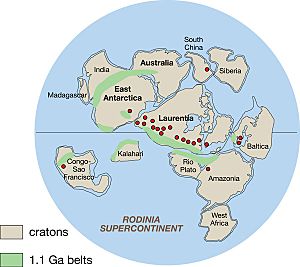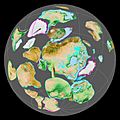Rodinia facts for kids
Rodinia was a huge supercontinent that held most of Earth's land. Its name means "to give birth." Rodinia existed a very long time ago, between 1.1 billion and 750 million years ago. It formed from pieces of an even older supercontinent.
Rodinia started to break apart during a period called the Tonian. Later, its pieces came back together to form another famous supercontinent called Pangaea, about 300 to 250 million years ago. Scientists know more about Pangaea than they do about Rodinia.
The breaking apart of Rodinia might have caused big changes on Earth. Around 700 million years ago, the planet got very cold. This time is known as the Snowball Earth period. After this cold period, life on Earth started to change and grow quickly during the Ediacaran and Cambrian periods.
How Rodinia Broke Apart
Scientists understand more about how Rodinia broke apart than how it formed. Around 750 million years ago, there was a lot of volcanic activity. Huge amounts of lava flowed out, and the land started to pull apart. This pulling apart is called "rifting."
This rifting created new cracks in the Earth's crust. As early as 850 to 800 million years ago, a big crack formed. Over time, this crack grew wider and became a new ocean during the Ediacaran period.
Later, around 610 million years ago, another rifting event happened. This created the Iapetus Ocean. Some scientists think that all the land might have joined up again for a short time. This possible supercontinent is called Pannotia, and it existed between 600 and 550 million years ago.
Rodinia's Impact on Early Life
Rodinia itself was a barren land. No plants or animals lived on its dry surface. This was because the ozone layer had not fully formed yet. Without the ozone layer, the land was exposed to harmful ultraviolet radiation from the sun. This made it impossible for life to survive there.
However, Rodinia's existence likely affected the life in the oceans. During the Cryogenian period, Earth experienced huge glaciers. Temperatures were very cold, and large parts of Rodinia might have been covered by ice.
When the continents broke apart, new oceans formed. This process, called "seafloor spreading," created new, warmer ocean floor. This new ocean floor was not as deep as older, cooler parts. This caused the overall sea level to rise, creating more shallow seas.
More shallow seas meant more water could evaporate. This might have led to more rainfall. Increased rainfall could have washed more minerals from the land into the oceans. It also might have reduced the amount of carbon dioxide (a greenhouse gas) in the air. When carbon dioxide levels dropped, the "Snowball Earth" period began. The increased volcanic activity during the break-up also added important nutrients to the seas. These changes may have played a big role in the development of the earliest animals.
Images for kids
See also
 In Spanish: Rodinia para niños
In Spanish: Rodinia para niños



